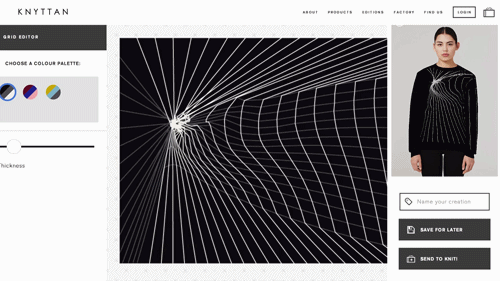Knyttan is a fashion startup or, if you would prefer a cultural reference, a 21st century incarnation of Cher’s closet in the opening scenes of the 1995 teen classic Clueless. In practice, the film’s build-your-own-wardrobe app looks an awful lot like the maker movement’s version of fashion design. You log in to the company’s website, pick an item of clothing—current offerings are limited to jumpers and scarves—and proceed to customize patterns that Knyttan has asked designers to contribute.
Those designers do not all hail from the world of fashion: Moniker is an interaction design studio; Nicolas Sasoon describes his work as being the “use of various computer-based processes to generate fantasized visions of architectures, landscapes and domestic environments.” As Fast Company reports, these unusual backgrounds are ideally suited for the sort of customizable designs that Knyttan aims to produce.
Once a finalized pattern and colour scheme has been settled upon, Knyttan weaves the pattern out of merino wool on a computerized knitting machine and assembles the garment, adding a label with the customer’s name listed as the designer. This is not fast fashion in the same sense as Forever 21, H&M, or Zara. As Rob Horning notes in his excellent N+1 essay on that industry, its constituent brands “have changed fashion from a garment making to an information business, optimizing their supply chains to implement design tweaks on the fly.”
Although Knyttan’s wares can be produced relatively quickly—under two hours for a sweater—their production centers on design as opposed to Forever 21’s neoliberal fantasy. At the same time, however, Knyttan is also considerably faster than traditional bespoke clothing; a proper suit made on Savile Row must have a minimum of three fittings and is crafted over a period of weeks if not months. From a temporal and manufacturing perspective, Knyttan shares far less with the fashion industry than it does with other fields where 3D printing and its relatives have allowed for new creative outputs.
The idea of customizing your wardrobe through an app is not limited to Clueless. Choosing the appearance of your videogame avatar is something that happens millions of times per day. (Indeed, the challenges of creating a videogame look in an orthographic editor that maps out well in 3D space should serve as a warning for budding e-fashion consumers.) The act of designing an avatar is ultimately not so dissimilar from the act of getting dressed in the morning insofar as both center on how you want to present yourself to the world. In that respect, Clueless may have always been in discussion with the world of videogames. Startups like Knyttan are just bringing that realization to the forefront of our minds, and into our closets.
